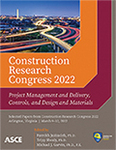Choosing by Advantages (CBA) Method to Determine Feasibility of Mass Timber Building Material in the US Construction Market
Publication: Construction Research Congress 2022
ABSTRACT
Construction projects involve multiple stakeholders that make numerous decisions during the design and construction phases. One of the crucial decisions is to select the most suitable building material for the project. Therefore, it is important to select a building material with low-environmental impacts. The decision-making process is not often managed in an organized manner. Many decisions are made without having a systemic approach to decision-making, thus generates conflict among the stakeholders. To overcome the challenges associated with decision-making, the study proposes a scientific decision-making framework called Choosing by Advantages (CBA). This process facilitates effective decision-making by aligning practical knowledge and subjective judgments. In this study, CBA is used to determine the feasibility of mass timber in the US construction industry. Concrete and steel were used as alternatives to compare with mass timber. Mass timber is a new form of building material that is still gaining momentum in the US market. Thus, it is nontrivial to evaluate the feasibility of this product. A total of 29 construction industry practitioners from different parts of the country participated in the study. The outcomes of the study provide evidence that the CBA tabular method is capable to select the best-suited building material by establishing the preference of the industry practitioners. It further stretches that although mass timber is not the most suitable alternative in terms of present situation, it has multiple positive features to be accepted as a mainstream building material in the US construction industry.
Get full access to this article
View all available purchase options and get full access to this chapter.
REFERENCES
Abraham, K., Lepech, M., and Haymaker, J. (2013). “Selection and application of choosing by advantages on a corporate campus project.” In: 21th Annual Conf. of the International Group for Lean Construction (IGLC 21), C. T. Formoso and P. Tzortzopoulos, eds., Fortaleza, Brazil, 349–358.
Ahmed, S., and Arocho, I. (2021). “Analysis of cost comparison and effects of change orders during construction: Study of mass timber and a concrete building project”. Journal of Building Engineering, 33, 101856. https://doi.org/10.1016/j.jobe.2020.101856.
Ahmed, S., and Arocho, I. (2019). “Emission of particulate matters (PM) during construction: A comparative study on a cross-laminated timber (CLT) and a steel building project”. Journal of Building Engineering, 22: 281–294. https://doi.org/10.1016/j.jobe.2018.12.015.
Ahmed, S., and Arocho, I. (2021). “Feasibility Assessment of Mass Timber as a Mainstream Building Material in the US Construction Industry: Level of Involvement, Existing Challenges, and Recommendations”. Practice Periodical on Structural Design and Construction, 26(2). DOI: https://doi.org/10.1061/(ASCE)SC.1943-5576.0000574.
Ahmed, S., and Arocho, I. (2020). “Mass timber building materials in the U.S. construction industry: Determining the existing awareness level, construction-related challenges, and recommendations to increase its current acceptance level”. Cleaner Engineering and Technology, DOI: https://doi.org/10.1016/j.clet.2020.100007.
Alzahrani, J., and Emsley, M. W. (2013). “The impact of contractors’ attributes on construction project success: A post-construction evaluation”. International Journal of Project Management, 31:313–322.
Arroyo, P., Tommelein, I. D., and Ballard, G. (2016). “Selecting globally sustainable materials: A case study using choosing by advantages”. Journal of Construction Engineering and Management. 142(2): 05015015. DOI: https://doi.org/10.1061/(ASCE)CO.1943-7862.0001041.
Chan, A. P. C., and Chan, A. P. L. (2004). “Key performance indicator for measuring construction success”. Benchmarking: An International Journal, 11(2): 203–221. DOI: https://doi.org/10.1108/14635770410532624.
Fischer, M., and Adams, H. (2011). “Engineering-based decision in construction”. Journal of Construction Engineering and Management. 751–754. DOI: https://doi.org/10.1061/(ASCE)CO.1943-7862.0000304.
Mallo, M., and Espinoza, O. (2015). “Awareness, perceptions and willingness to adopt cross- laminated timber by the architect community in the United States”. Journal of Cleaner Production, 94:198–210.
Mohammadi, J., and Ling, L. (2017). “Can wood become an alternative material for tall building construction?”. Practice Periodical on Structural Design and Construction, 22(4):04017014. DOI: https://doi.org/10.1061/(ASCE)SC.1943-5576.0000334.
NCSU. (2018). “Mass Timber Products: Innovative Wood-Based Building Materials”. NC State Extension Publications. Retrieved 2021 from: https://content.ces.ncsu.edu/mass-timber-products-innovative-wood-based-building-materials.
Nnaji, C., Lee, H. W., Karakhan, A., and Gambatese, J. (2018). “Developing a decision-making framework to select safety technologies for highway construction”. Journal of Construction Engineering and Management. 144(4): 04018016. DOI: https://doi.org/10.1061/(ASCE)CO.1943-7862.0001466.
Oehlberg, L., Shelby, R., and Agogino, A. (2010). “Sustainable product design: Designing for diversity in engineering education.” International Journal of Engineering Education. 26(2), 489–498.
Parviz, F. R. (2003). “Project success attributes.” Journal of Cost Engineering, 45(4): 23–28.
Sigurour, S. F. (2009). “Critical success factor in project management: An ethical perspective”. School of Engineering and Natural Sciences, University of Iceland. https://skemman.is/bitstream/1946/3020/1/SFS_Meistaraverkefni_fixed.pdf.
Steinfort, P., and Walker, D. (2007). “Critical success factors in project management globally and how they may be applied to aid projects”. In: Baccarini (ed.) Proceedings of the PMOZ Achieving Excellence- 4th Annual Project Management Australia Conference, Brisbane, Australia, 28–31.
Suhr, J. (1999). The choosing by advantages decision making system. Quorum, Westport, CT.
Sun, S., Zhao, Z., and Shen, J. 2020. “Effects of manufacturing conditions on the VOCs emissions of particleboard.” Bioresources 15 (1): 1074–1084. https://bioresources.cnr.ncsu.edu/resources/effects-of-the-manufacturing-conditions-on-the-vocs-emissions-of-particleboard/.
Information & Authors
Information
Published In
History
Published online: Mar 7, 2022
Authors
Metrics & Citations
Metrics
Citations
Download citation
If you have the appropriate software installed, you can download article citation data to the citation manager of your choice. Simply select your manager software from the list below and click Download.
